The Richter Archive at 75

Richter sat for this portrait prior to an exhibition on Giorgione at Johns Hopkins University, where he was the keynote speaker for a lecture series.
Conway Studios, New York, George Martin Richter, January 1942, silver gelatin print, Gigi Crompton Richter Collection, England
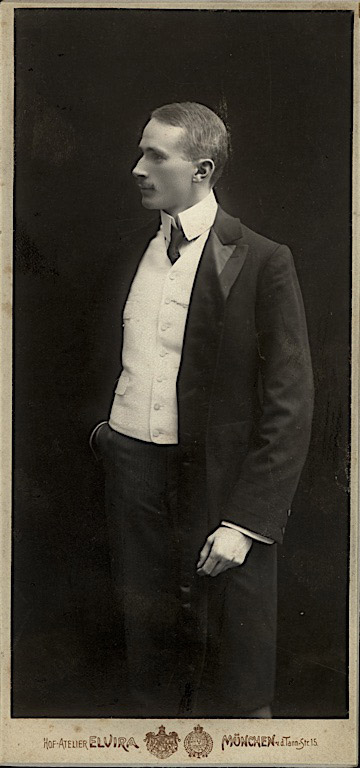
This cabinet card size photo was taken of Richter upon completion of his doctoral degree in 1907 at the Ludwig Maximilian University, Munich.
Sophia N. I. Goudstikker (Hof Atelier Elvira, Munich), 1865–1924, George Martin Richter, 1907, matte collodion print

This painting, now considered to be by Titian, once hung in Albury Park, Surrey, home of the Dowager Duchess of Northumberland.
Anonymous, United Kingdom, Cardinal Georges d’Armagnac and His Secretary Guillaume Philandrier by Titian, in the collection of the Duke of Northumberland, Alnwick Castle, 1931, carbon print

This painting, now considered to be by Titian, once hung in Albury Park, Surrey, home of the Dowager Duchess of Northumberland. Richter went to see the painting and took his daughter Gigi with him. She had previously been sent to Berlin to study drawing. She produced a handful of sketches that are part of the Richter Archive, along with George’s more crudely drawn sketches of various works of art.
Gigi Richter Crompton, b. 1922, Rendering of Cardinal Georges d’Armagnac and His Secretary Guillaume Philandrier by Titian in the collection of the Duke of Northumberland, Alnwick Castle, c. 1937, pencil on tracing paper

Richter devised his own system for keeping order amongst his growing photo archive, arranging them first by school, then by artist and theme.
George Martin Richter, 1875–1942, Handwritten Key to the Richter Classification System, c. 1920–1924, ink and pencil in a leather-bound Baschaga notebook

Some material from the Richter Archive devoted to costume history remains in the original boxes and folders. The contents of this box depict costumes from 1821 to the mid-20th century, including J. A.D. Ingres’s portrait Madame Moitessier in the Samuel H. Kress Collection of the National Gallery of Art.
Arrangement of materials from Box 10 of the Richter Archive section devoted to costume history

This photo dates from the time that the painting was still in the Allendale collection and before it was acquired by Samuel H. Kress in 1938.
Anonymous, Adoration of the Shepherds by Giorgione (Allendale Nativity) in the Samuel H. Kress Collection, National Gallery of Art, 1935, gelatin silver print, George M. Richter Archive

This is Richter’s annotated and corrected copy that was presented to Michael Straight by Gigi Richter Crompton, his cousin-in-law. The book is “Grangerized”—that is, blank sheets were bound into the copy for annotations.
George Martin Richter, 1875–1942, Giorgio da Castelfranco, called Giorgione (Chicago, 1937). Loaned by Dorothy Straight, Newbury, MA

Rebay, cousin to Mrs. Richter, was crucial in bringing the archive to the Gallery.
Anonymous, New York, Hilla von Rebay, 1947, gelatin silver print, Hilla von Rebay Archive

This assembled pair of daguerreotypes shows works of art depicting George and Martha Washington. James Sharples executed the pastel of President Washington in 1796 or 1797. George Washington Parke Custis, the president’s step-grandson, recalled that the artist had used a mechanical instrument, a physiognotrace, to ensure the accuracy of his subject’s profile. The miniature of Martha by Walter Robinson was painted on ivory and dates to 1794. It descended in ownership to the Custis-Lee family and is presumed to have been lost during the Civil War, when a barge containing the contents of the family’s Arlington House capsized on the Potomac.
Anonymous, United States, Martha Washington and George Washington, 1852–1858, daguerreotype in thermoplastic case
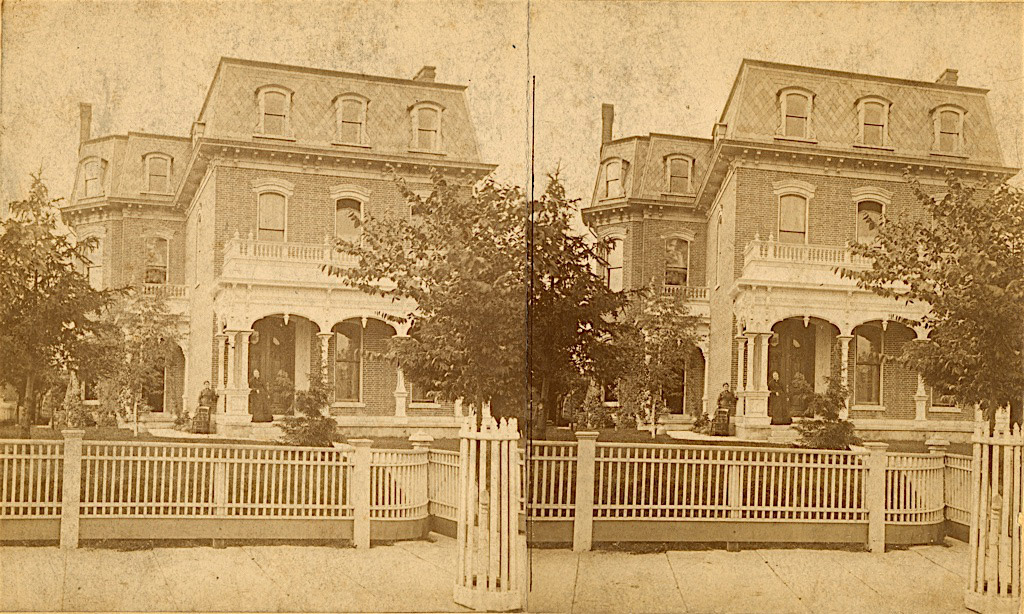
Stereographs, an early form of 3-D photography, provided depth to the depicted scene when the image was seen through a special viewer. Mass-produced images of landscapes, artworks, or architecture, like the Cole residence in Indiana, were popular in the 19th century and commonly found in even modest homes as a source of entertainment.
J. W. Husher, 1827–1879, J. W. Cole’s House, 511 East Washington Street, Greencastle, Indiana, c. 1873, albumen stereograph
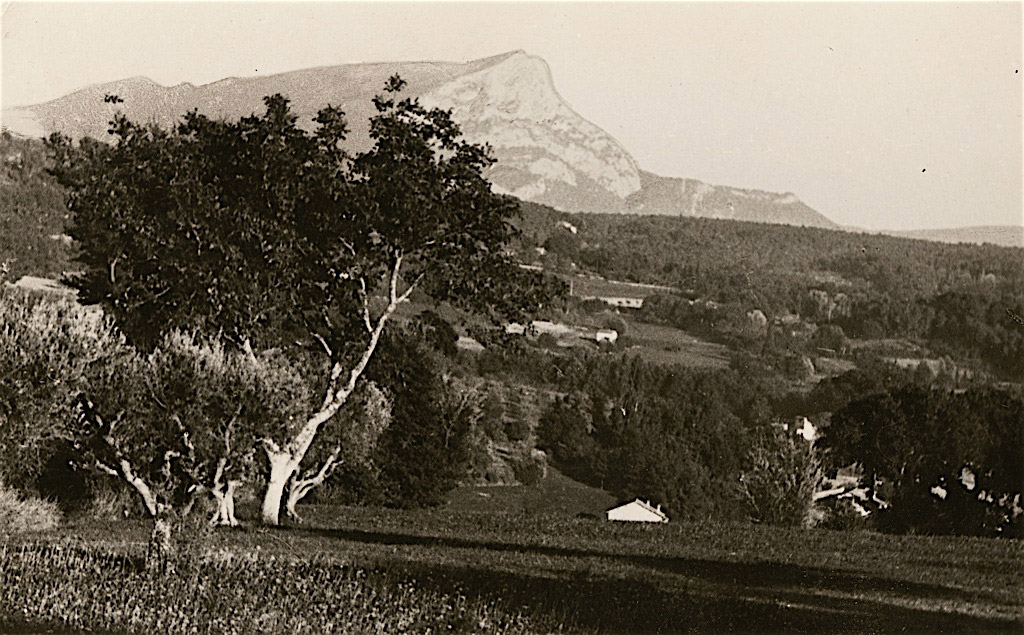
John Rewald, author of the catalogue raisonné of Paul Cézanne’s work, travelled with his friend Leo Marchutz around France in 1932 and 1933 to document the landscape motifs employed by Cézanne in his painting, as he feared that time would ruin the views that Cézanne depicted. In this photograph Marchutz shows a view of Mont Sainte Victoire, which Cézanne painted several times over the course of his career.
Léo Marchutz, 1903–1976, Mont Sainte Victoire Seen from Les Lauves, 1932, gelatin silver print, John Rewald Archive

John Rewald, author of the catalogue raisonné of Paul Cézanne’s work, travelled with his friend Leo Marchutz around France in 1932 and 1933 to document the landscape motifs employed by Cézanne in his painting, as he feared that time would ruin the views that Cézanne depicted. The pair also documented Cézanne’s studio, where Rewald recreated vignettes using the props left in the studio after the artist’s death.
Léo Marchutz, 1903–1976, The Interior of Cézanne’s Studio at Les Lauves, 1932, gelatin silver print, John Rewald Archive

Art historian Richard Offner assembled a remarkable photographic archive of Florentine Renaissance paintings that he deposited at the Institute of Fine Arts at New York University. When the Institute could no longer house them, they were donated to the Gallery, where they are an invaluable tool to researchers of Italian painting. This example of a panel painting in the Metropolitan Museum of Art was photographed in 1930.
Anonymous, United States, Totila before Saint Benedict by Benozzo Gozzoli in the Metropolitan Museum of Art, 1930, gelatin silver print, Richard Offner Archive, Gift of the Institute of Fine Arts, New York University

Art historian Richard Offner assembled a remarkable photographic archive of Florentine Renaissance paintings that he deposited at the Institute of Fine Arts at New York University. When the Institute could no longer house them, they were donated to the Gallery, where they are an invaluable tool to researchers of Italian painting. This example of a panel painting in the Metropolitan Museum of Art was photographed in 1930.
Anonymous, United States, The Conversion of Saul by Benozzo Gozzoli in the Metropolitan Museum of Art, 1930, gelatin silver print, Richard Offner Archive, Gift of the Institute of Fine Arts, New York University

The Library has an unusually large collection of prints by this Spanish photographer and his firm—the subject of a library exhibition in 2011. This view of the new Bullring in Madrid was taken just after construction was completed and shows Laurent’s eye for composition.
Juan Laurent, 1816–1886, General View of the New Bullring, Madrid, c. 1874, albumen silver print

The Gallery acquired the archive of the important 19th-century British photographer Francis Bedford in 2016. It contains approximately 4,400 photographs and two index volumes that survey British and Welsh architecture and landscape.
Sir Francis Bedford, 1816–1894, Guys Cliff from the River, albumen print, Francis Bedford Archive

Many of the photographs by Kennedy, an art historian and photographer, have been in the Library’s collection for years as part of the library of Gallery founder Joseph Widener. The original group has been augmented by additional gifts and purchases of Kennedy’s work. Kennedy became interested in creating photographs as a means of expressing “in the most sympathetic way, the character of the forms as the sculptor left them, complete and valid in their own right.” He began photographing sculpture in the 1920s and was close friends with photographer Ansel Adams.
Clarence Kennedy, 1892–1972, Portrait of a Woman: Back of Head Facing One Third to the Left by Francesco Laurana, from Studies in the History and Criticism of Sculpture, vol. 3. (Northampton, MA, 1928), gelatin silver print

Brumfield, a professor of Slavic languages at Tulane University, began documenting Russian architecture in the 1970s and has published extensively in this area. His many photographic campaigns preserve in film the many structures that have now been lost and provide extensive documentation of well-known structures, like Rastrelli’s Saint Andrew in Kiev.
William Craft Brumfield, b. 1944, South and West Façade of Saint Andrew, Kiev, by Bartolomeo Francesco Rastrelli, 1983, gelatin silver print, William Craft Brumfield Archive

This photo of Eugene Delacroix by Victor Laisné, who experimented briefly with the new medium of photography in the mid-19th century, was the model for the stipple engraving of Delacroix's visage used in Histoire des artistes vivants français et étrangers: études d'après nature by Theophile Silvestre. Photos by Laisné are very scarce.
Victor Laisné, 1825–1897, Eugene Delacroix, 1852, salted paper print from waxed paper negative on original trimmed lithographed mount, purchased with funds from Earle and Ellen McVicker Layman

Theophile Silvestre published his Histoire des artistes vivants français et étrangers: études d'après nature in various editions from 1853 on. He had the painter Victor Laisné, who was experimenting with photography, produce portraits of artists in this new medium that were used as the models for the engravings in his book.
Stipple engraving of Victor Laisné’s photograph of Eugene Delacroix, included in Theophile Silvestre, 1823–1876, Histoire des artistes vivants français et étrangers: études d'après nature (Paris, 1856), National Gallery of Art Library

In 2014 the family of the artist William A. Smith donated his collection of artists’ portraits, some created as part of a UNESCO cultural exchange between the United States and the Soviet Union. He continued his study of artists, many of whom became his friends, both at home and in his travels in Asia. This unusual enlarged contact sheet, with frames marked in wax pencil, shows his neighbor Andrew Wyeth.
William A. Smith, 1918–1989, Andrew Wyeth at His Home, Chadds Ford, PA, 1957, printed May 28, 1957, gelatin silver print (enlarged contact sheet with six frames) and grease pencil notations, William A. Smith Archive
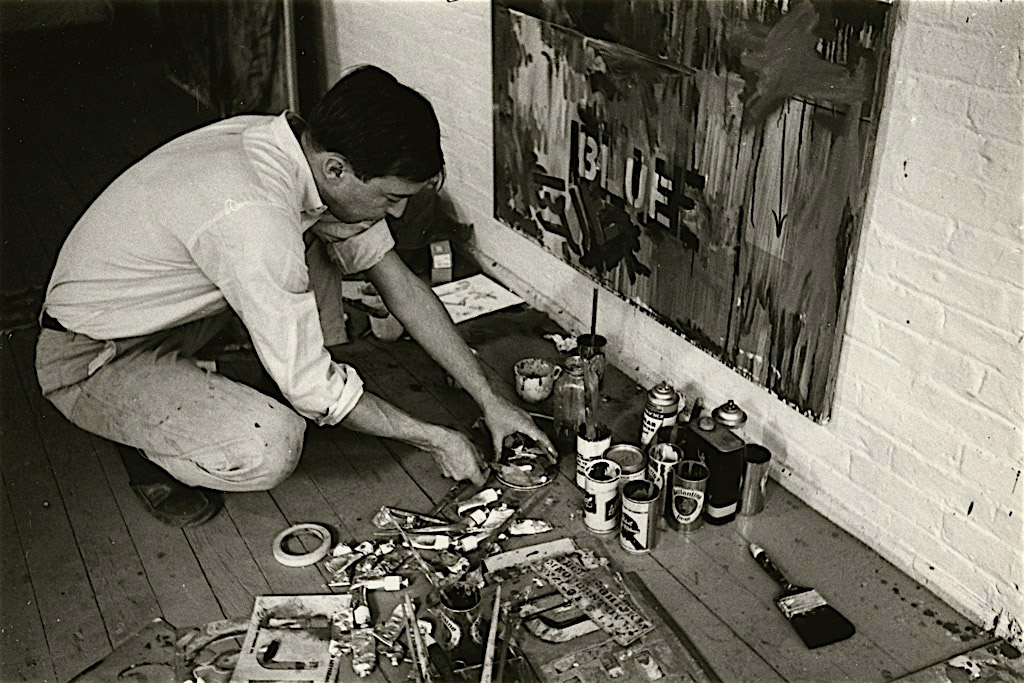
Artist Paul Katz had a day job as photographer for the Solomon Guggenheim Museum. He would visit his friends in their studios and snap pictures of them at work, like this view of Jasper Johns working on Periscope (Hart Crane) (1962).
Paul Katz, b. 1942, Jasper Johns with Periscope (Hart Crane), Front Street Studio, New York, 1963, gelatin silver print, Paul Katz Archive

After the death of Édouard Manet in 1883, his friends arranged a memorial exhibition of his work at the École des Beaux-Arts in February 1884 that was photographed by Jules-Michel Godet. The paintings, hung in tiers against a draped background, are now in museum collections around the world. In this example, two paintings now in the Gallery’s collection can be seen coincidentally hanging side by side: Plum Brandy and The Melon. Until The Melon was donated to the Gallery by Mr. and Mrs. Paul Mellon following Mrs. Mellon’s death in 2014 and the work was spotted in this photograph, it was not known to have been included in this exhibition.
Jules-Michel Godet, active 1860s–c. 1886, View of the Exposition Manet in the Salle de Melpomène at the École Nationale Supérieure des Beaux-Arts, albumen print

The department of image collections has built extensive holdings of photographic material documenting world’s fairs, dating from Prince Albert’s Great Exhibition at the Crystal Palace in 1851 to Montreal’s Expo ‘67. These expositions often had elaborate parks filled with temporary structures showcasing the latest technological innovations or exhibitions of art that attracted visitors from across the globe. The 1904 St. Louis World’s Fair, officially the Louisiana Purchase Exposition, filled what was then the suburban Forest Park with halls for the exhibiting countries that surrounded a vast lagoon.
Louisiana Purchase Exposition Company, Panorama of the Louisiana Purchase International Exposition: Grand Basin from Art Hill, 1904, albumen print
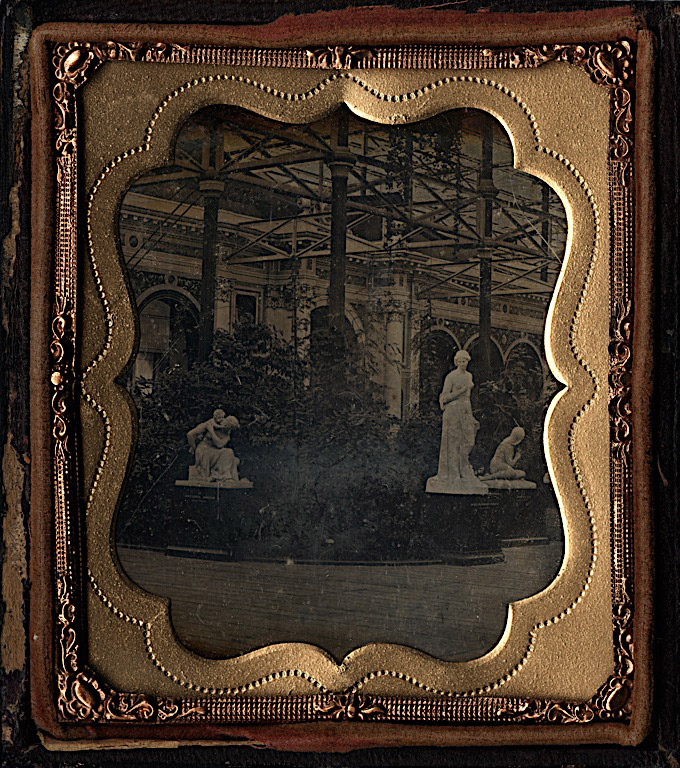
The department of image collections has built extensive holdings of photographic material documenting world’s fairs, dating from Prince Albert’s Great Exhibition at the Crystal Palace in 1851 to Montreal’s Expo ‘67. These expositions often had elaborate parks filled with temporary structures showcasing the latest technological innovations or exhibitions of art that attracted visitors from across the globe.
Anonymous, Great Exhibition of 1851: The Crystal Palace, Interior of the Atrium Court, as reconstructed at Sydenham, 1854, daguerreotype in leather case

The department of image collections has built extensive holdings of photographic material documenting world’s fairs, dating from Prince Albert’s Great Exhibition at the Crystal Palace in 1851 to Montreal’s Expo ‘67. These expositions often had elaborate parks filled with temporary structures showcasing the latest technological innovations or exhibitions of art that attracted visitors from across the globe. The Centennial Exposition in Philadelphia marked the 100th anniversary of the founding of the United States.
Centennial Photographic Company, View of Italian Section in the Memorial Hall Annex with the Madonna of the Harpies by Andrea del Sarto, from the Galleria degli Uffizi, 1876, albumen stereo card

Fenton, known for his fine art photography and his eloquent images of the Crimean War, was also a photographer for the British Museum from 1854 to 1859. In his specially designed rooftop studio he photographed a wide variety of museum objects, including works on paper like this 1660 drawing by Claude Lorrain. The prints of Fenton’s photograph were produced in large quantities and retailed by the London print dealer P. & D. Colnaghi & Co.
Roger Fenton, 1819–1869, Journey to Emmaus by Claude Lorrain, 1858, salted paper print

While the vast majority of the Gallery’s image collections comprise photographic material, the department also has a small but impressive collection of reproductive prints. Reproductive prints first appear in the 16th century as a way to document princely art collections and those of other noble families and to disseminate knowledge of art to a wider audience. A significant set of calcographic prints—prints made from the original plates but in the early 20th century—were transferred from the Library of Congress to the Gallery in 1986.
Alfred-Louis Brunet-Debaines, 1845–1939, The Mill by Rembrandt van Rijn, 1880, etching, Calcographic Print Collection

While the vast majority of the Gallery’s image collections comprise photographic material, the department also has a small but impressive collection of reproductive prints. Reproductive prints first appear in the 16th century as a way to document princely art collections and those of other noble families and to disseminate knowledge of art to a wider audience. In 2005 Peter and Evelyn Kraus donated their collection of almost 500 primarily Dutch portrait prints to the department. The Kraus Collection contains etchings, engravings, and mezzotints, and in some cases multiple copies and states of the same sitter. This collection has been fully cataloged and digitized.
Jonas Suyderhoff, c. 1636–c. 1686, Eleazar Swalmius by Rembrandt van Rijn, state i/iii, after 1637, engraving, Peter and Evelyn Kraus Collection